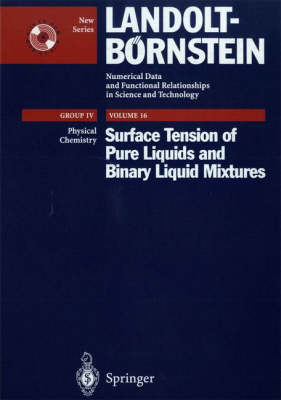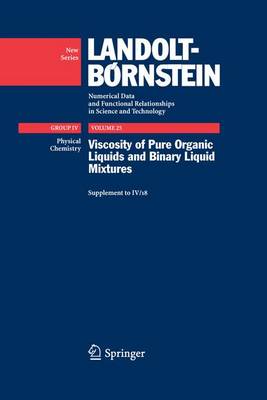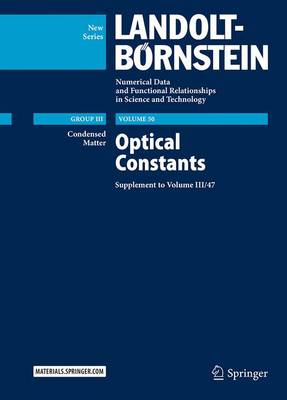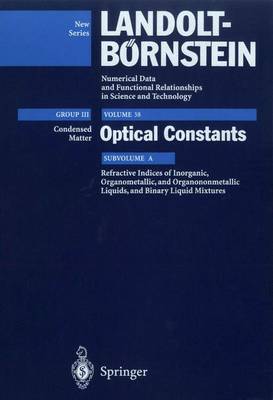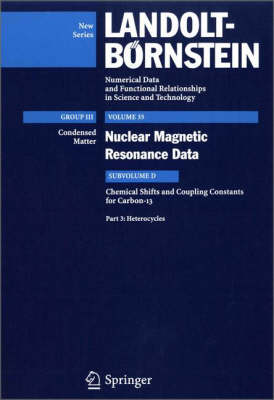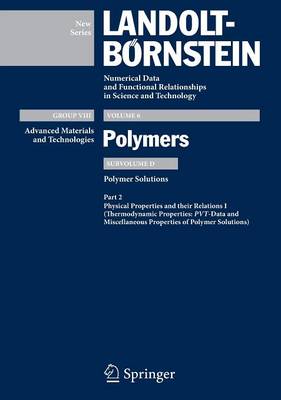Landolt-Boernstein: Numerical Data and Functional Relationships in Science and Technology - New
3 primary works • 7 total works
Book 24
Surface Tension of Pure Liquids and Binary Liquid Mixtures
by Christian Wohlfarth and M. D. Lechner
Book 29
Viscosity of Pure Organic Liquids and Binary Liquid Mixtures
by Christian Wohlfarth
Book 50
D3
Polymers belong to an essential material group with many applications not only for polymer manufacturers but also in physics, chemistry, medicine and engineering techniques. The presented volume is the third part of a book series connecting a complete data collection with short but precise descriptions of the different quantities and their significances. The experimental determination of the physical quantities is given as well as the influence to other physical quantities. This volume helps to choose the best material for all kinds of applications also for those which are not mentioned in polymer material books. It is focused on polymers in solutions and is intended for scientists and researchers who work on practical problems in the polymer field and who are in the need of numerical data on polymer properties.
38A
Part A contains the inorganic, organometallic, and organononmetallic liquids, and the binary liquid mixtures (about 900 pure substances and their mixtures).
Part B contains data of more than 7600 organic liquids. Since not all data for the organic compounds and mixtures could be included in the printed version the second part additionally contains an electronic version of the complete collection with all available data and references.
35D3
Nuclear Magnetic Resonance (NMR) is based on the fact that certain nuclei exhibit a magnetic moment, orient by a magnetic field, and absorb characteristic frequencies in the radiofrequency part of the spectrum. The spectral lines of the nuclei are highly influenced by the chemical environment i.e. the structure and interaction of the molecules. NMR is now the leading technique and a powerful tool for the investigation of the structure and interaction of molecules. The present Landolt-Börnstein volume III/35 Nuclear Magnetic Resonance (NMR) Data is therefore of major interest to all scientists and engineers who intend to use NMR to study the structure and the binding of molecules. Volume III/35 ''NMR-Data'' is divided into several subvolumes and parts. Subvolume III/35A contains the nuclei B-11 and P-31, subvolume III/35B contains the nuclei F-19 and N-15, subvolume III/35C contains the nucleus H-1, subvolume III/35D contains the nucleus C-13, subvolume III/35E contains the nucleus O-17, and subvolume III/35G contains the nucleus Se-77. More nuclei will be presented later.
6D2
PVT-Data and Miscellaneous Properties of Polymer Solutions
by Christian Wohlfarth
Polymers belong to an essential material group with many applications not only for polymer manufacturers but also in physics, chemistry, medicine and engineering techniques. The presented volume is the second part of a book series connecting a complete data collection with short but precise descriptions of the different quantities and their significances. The experimental determination of the physical quantities is given as well as the influence to other physical quantities. This volume helps to choose the best material for all kinds of applications also for those which are not mentioned in polymer material books. It is focused on polymers in solutions and is intended for scientists and researchers who work on practical problems in the polymer field and who are in the need of numerical data on polymer properties.
